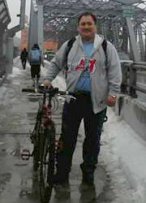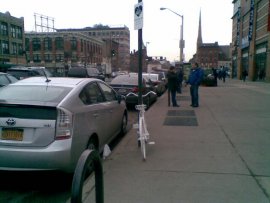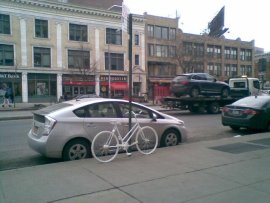Pedro Santiago
Pedro Santiago
Sunday, January 19, 2014
Age: 45
Location:
Lenox Ave. and 125th Street
New York City , NY
United States
Pedro was an experienced bicycle delivery person who loved to ride his bike and read classic literature. Late one sunday night his life was cut short by the driver of a MTA bus.
From The New York Times
Bicyclist Killed by a Bus Rose Above Usual Anonymity of Deliverymen in the City
In
life, he was another anonymous bicycle deliveryman who traveled the
streets of New York City. To many pedestrians he was no more than a
nuisance, and to his customers, never fast enough.
In
death, he was still anonymous. The news reports identified him only as
Pedro Santiago, 45, who was riding his bicycle around 1:30 a.m. Sunday,
when he was struck and killed by a Metropolitan Transportation Authority bus on West 125th Street in Harlem. He was one of four people fatally struck by vehicles
on the city’s streets last weekend, leading a spokesman for Mayor Bill
de Blasio to declare an “urgent need to make our streets safer.”
Mr.
Santiago was among the forgettable faces of the workers in the service
economy, the person who facilitated the lifestyle that New Yorkers take
for granted. They cook, they clean. They make it possible for children
to grow up thinking that when the doorbell rings, it is time to eat.
“All
of us kind of use them a lot,” said Henry Rinehart, the owner of
Henry’s, a bistro at 105th Street and Broadway, where Mr. Santiago once
worked, “but they completely fall below the radar of the human scale,
and Pedro is a really good example of that — educated, smart, very
thoughtful.”
To
a close-knit network of waiters, dishwashers, deliverymen, street
peddlers and restaurant managers up and down the Upper West Side of
Manhattan, this was not just the anonymous death of an anonymous Pedro.
He was the gregarious deliveryman who made friends with customers, who
sat and read Dostoyevsky and Cervantes in two languages during his
downtime, who sent money back to Mexico to support his family and who
took classes at Columbia and Hofstra Universities, with the dream of
becoming an engineer who would build bridges and roads.
“I
think he liked serving food,” Mr. Rinehart said. “Henry’s has a lot of
repeat customers. He was always very able to connect with people very
quickly. He was everything you would want in an employee. Very punctual.
Very thoughtful, very considerate of others.”
Even
after Mr. Santiago moved on to another job — always trying to balance
his schedule with his continuing education classes — he still went back
to Henry’s often to say hello.
About
nine years ago, Peter Soter, then the owner of Morningside Bookshop
near Columbia University, noticed a pudgy, good-humored customer who
came in every couple of weeks to order books in English and Spanish.
“What are you going to do with these books?” Mr. Soter asked. “I’m going
to read them,” Mr. Santiago replied. At the time, Mr. Santiago did not
speak English well, but Mr. Soter was so impressed that he offered him a
job, sweeping, delivering books, sometimes helping customers.
“After
working for me for four years, he became like part of the family,” Mr.
Soter said. “I trusted him with my kids. When I went on vacation, he fed
my cats, watered my plants.”
Mr.
Santiago, who had lived in the United States for about 17 years, had
crossed the border from Mexico twice, spending frigid nights in the
desert, according to his father, Serafin Pedro Santiago. Eventually, he
got his high school equivalency diploma, friends said.
Over
the years, he bussed tables for Columbia students and professors at the
old West End bar and delivered cookies late at night for Insomnia Cookies, friends said.
The
day after he died, Mr. Santiago was scheduled to start a new job as a
runner — the person who brings the food to the table — at Amsterdam
Restaurant and Tapas Lounge at 120th and Amsterdam Avenue, his friend
Neftali Tapia, a restaurant counterman, said.
Mr.
Santiago rode his bicycle everywhere, even when he was not working,
stopping often to greet people he knew. It was like a part of him, Mr.
Tapia said.
Mr.
Santiago was traveling east on 125th Street toward Lenox Avenue on his
way home to East Harlem, on the driver’s side, near the double yellow
line, when he was hit by the Bx15, an articulated bus, at 1:26 a.m., the
police said; he passed the bus as it was pulling away from a stop, and
“immediately pulled in front.” The police said the driver hit the
brakes, but the bus hit Mr. Santiago’s rear tire, throwing him to the
pavement, where he was run over. He was pronounced dead on arrival at
Harlem Hospital Center. No one was charged or given a ticket.
Marisa
Baldeo, a spokeswoman for the M.T.A., said Thursday that she could not
provide details of the driver’s record because the accident was still
under investigation.
Riding
on the left side is the safest way to pass a bus, because the cyclist
is more visible to the driver and less likely to be squeezed if the bus
pulls toward the curb, according to Caroline Samponaro, a senior
director at Transportation Alternatives, which advocates walking, bicycling and public transit as opposed to driving.
“I would do the same thing, to be visible,” she said. “Inevitably, you do have to pass buses at times.”
But the lack of a bike lane on 125th Street and the busy two-way traffic, even at night, make it dangerous, Ms. Samponaro said.
Mr.
Rinehart, who worked as a bicycle messenger in his youth, said Mr.
Santiago had always been concerned about safety. “When there was bad
weather, he’d say, ‘I’m going to be a little slow,’ ” Mr. Rinehart said.
Friends
are now trying to raise money to send Mr. Santiago’s body back to his
family in Mexico, where he has parents, two daughters, a son and a
grandchild, with another on the way. The Mexican consulate has promised
$1,700.
His
friends said Mr. Santiago’s family hoped the M.T.A., as a kindness,
would pay to ship the body. But Ms. Baldeo said she could not comment on
that.
“I was told that we couldn’t answer any questions about compensation because it’s still under investigation,” she said.
The crash was also covered in the NY Post and the Daily News
Sunday, January 19, 2014
Age: 45
Location:
Lenox Ave. and 125th Street
New York City , NY
United States
Pedro was an experienced bicycle delivery person who loved to ride his bike and read classic literature. Late one sunday night his life was cut short by the driver of a MTA bus.
From The New York Times
Bicyclist Killed by a Bus Rose Above Usual Anonymity of Deliverymen in the City
In
life, he was another anonymous bicycle deliveryman who traveled the
streets of New York City. To many pedestrians he was no more than a
nuisance, and to his customers, never fast enough.
In
death, he was still anonymous. The news reports identified him only as
Pedro Santiago, 45, who was riding his bicycle around 1:30 a.m. Sunday,
when he was struck and killed by a Metropolitan Transportation Authority bus on West 125th Street in Harlem. He was one of four people fatally struck by vehicles
on the city’s streets last weekend, leading a spokesman for Mayor Bill
de Blasio to declare an “urgent need to make our streets safer.”
Mr.
Santiago was among the forgettable faces of the workers in the service
economy, the person who facilitated the lifestyle that New Yorkers take
for granted. They cook, they clean. They make it possible for children
to grow up thinking that when the doorbell rings, it is time to eat.
“All
of us kind of use them a lot,” said Henry Rinehart, the owner of
Henry’s, a bistro at 105th Street and Broadway, where Mr. Santiago once
worked, “but they completely fall below the radar of the human scale,
and Pedro is a really good example of that — educated, smart, very
thoughtful.”
To
a close-knit network of waiters, dishwashers, deliverymen, street
peddlers and restaurant managers up and down the Upper West Side of
Manhattan, this was not just the anonymous death of an anonymous Pedro.
He was the gregarious deliveryman who made friends with customers, who
sat and read Dostoyevsky and Cervantes in two languages during his
downtime, who sent money back to Mexico to support his family and who
took classes at Columbia and Hofstra Universities, with the dream of
becoming an engineer who would build bridges and roads.
“I
think he liked serving food,” Mr. Rinehart said. “Henry’s has a lot of
repeat customers. He was always very able to connect with people very
quickly. He was everything you would want in an employee. Very punctual.
Very thoughtful, very considerate of others.”
Even
after Mr. Santiago moved on to another job — always trying to balance
his schedule with his continuing education classes — he still went back
to Henry’s often to say hello.
About
nine years ago, Peter Soter, then the owner of Morningside Bookshop
near Columbia University, noticed a pudgy, good-humored customer who
came in every couple of weeks to order books in English and Spanish.
“What are you going to do with these books?” Mr. Soter asked. “I’m going
to read them,” Mr. Santiago replied. At the time, Mr. Santiago did not
speak English well, but Mr. Soter was so impressed that he offered him a
job, sweeping, delivering books, sometimes helping customers.
“After
working for me for four years, he became like part of the family,” Mr.
Soter said. “I trusted him with my kids. When I went on vacation, he fed
my cats, watered my plants.”
Mr.
Santiago, who had lived in the United States for about 17 years, had
crossed the border from Mexico twice, spending frigid nights in the
desert, according to his father, Serafin Pedro Santiago. Eventually, he
got his high school equivalency diploma, friends said.
Over
the years, he bussed tables for Columbia students and professors at the
old West End bar and delivered cookies late at night for Insomnia Cookies, friends said.
The
day after he died, Mr. Santiago was scheduled to start a new job as a
runner — the person who brings the food to the table — at Amsterdam
Restaurant and Tapas Lounge at 120th and Amsterdam Avenue, his friend
Neftali Tapia, a restaurant counterman, said.
Mr.
Santiago rode his bicycle everywhere, even when he was not working,
stopping often to greet people he knew. It was like a part of him, Mr.
Tapia said.
Mr.
Santiago was traveling east on 125th Street toward Lenox Avenue on his
way home to East Harlem, on the driver’s side, near the double yellow
line, when he was hit by the Bx15, an articulated bus, at 1:26 a.m., the
police said; he passed the bus as it was pulling away from a stop, and
“immediately pulled in front.” The police said the driver hit the
brakes, but the bus hit Mr. Santiago’s rear tire, throwing him to the
pavement, where he was run over. He was pronounced dead on arrival at
Harlem Hospital Center. No one was charged or given a ticket.
Marisa
Baldeo, a spokeswoman for the M.T.A., said Thursday that she could not
provide details of the driver’s record because the accident was still
under investigation.
Riding
on the left side is the safest way to pass a bus, because the cyclist
is more visible to the driver and less likely to be squeezed if the bus
pulls toward the curb, according to Caroline Samponaro, a senior
director at Transportation Alternatives, which advocates walking, bicycling and public transit as opposed to driving.
“I would do the same thing, to be visible,” she said. “Inevitably, you do have to pass buses at times.”
But the lack of a bike lane on 125th Street and the busy two-way traffic, even at night, make it dangerous, Ms. Samponaro said.
Mr.
Rinehart, who worked as a bicycle messenger in his youth, said Mr.
Santiago had always been concerned about safety. “When there was bad
weather, he’d say, ‘I’m going to be a little slow,’ ” Mr. Rinehart said.
Friends
are now trying to raise money to send Mr. Santiago’s body back to his
family in Mexico, where he has parents, two daughters, a son and a
grandchild, with another on the way. The Mexican consulate has promised
$1,700.
His
friends said Mr. Santiago’s family hoped the M.T.A., as a kindness,
would pay to ship the body. But Ms. Baldeo said she could not comment on
that.
“I was told that we couldn’t answer any questions about compensation because it’s still under investigation,” she said.
The crash was also covered in the NY Post and the Daily News


